#scottish targe
Explore tagged Tumblr posts
Text
thinking about watch the starks do, like what this historical family business is, in a modern au and i’m erring toward something like sheep and/or cattle herding. Like they have a farm up in the highlands and all the kids had to put time in growing up (to sansa’s horror and arya’s joy) as like, an important life thing and now the kids are off doing whatever. Its a family farm that’s been around for ages.
Its all a bit up in the air rn bc i’m thinking that their family is historically highlanders who were you know, forcibly removed from their lands to facilitate those sheep farms. So i’m trying to find a sensible mix of like, real history and at least the spirit of stark lore (so like, very old and establish family, og pop, well off, etc)
#headcanons / ooc.#Making them scottish adds so many new issues but the scottish working for the english does at least work w/ the post targ vibe
6 notes
·
View notes
Text

A drawing reconstructing a Jacobite, labeled “Glengary,” from the Penicuik Sketches of Bonnie Prince Charlie’s army during the Uprising of 1745.
#sketch#Historically plausible#Highlander#scotland#jacobite#scottish highlands#broadsword#targe#The ‘45#Uprising of 1745
6 notes
·
View notes
Text
Griffin and Sword Targe for Fergus O'Dae

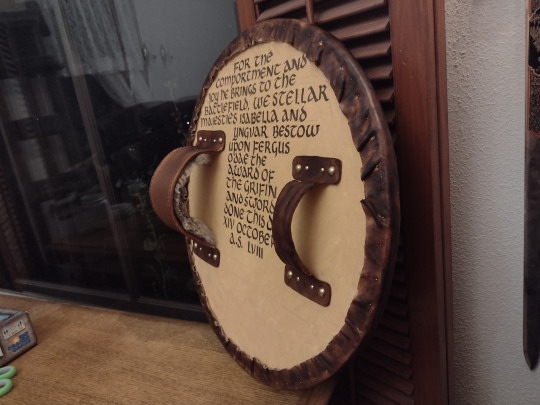
This is a build log for a late period Scottish targe for Fergus O'Dae, a border reaver and rising star of the Northshield Army. The Griffin and Sword is our Award of Arms-level award for excellency in armored combat.

Before starting the design, I layed out my idea using Heraldicon, a free website built to be even more powerful than Drawshield for assembling coats of arms. I thought it would be very fetching to have the Northshield populace badge outlined in the brass studs characteristic to targes, with the griffin and sword represented with different colored metals.

Laying out the carving and the tacks. A missed step in this album is cutting the wooden core. I actually already had a 20" round of plywood lying around. It wasn't actually a shield blank; it was the center cutout of a wooden ring I made to hold the 3.5' long bolts on our giant electrical wire spool in a specific pattern so I could reassemble the whole thing.
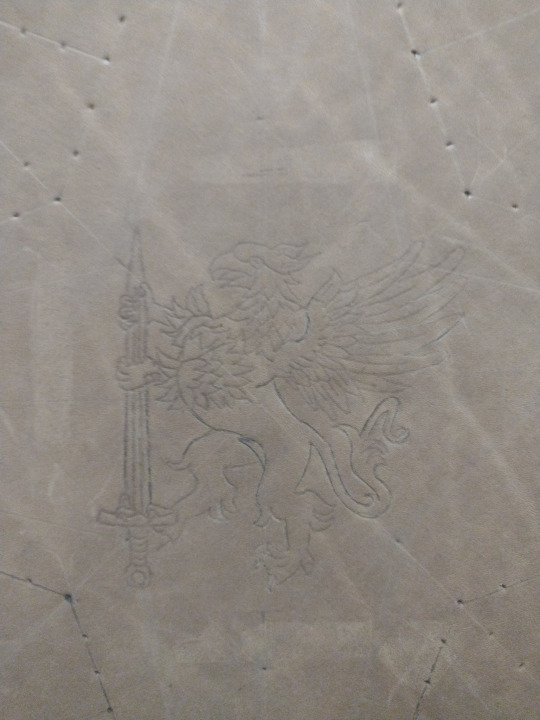
The griffin layout. Many thanks go to Heraldic Traceable Art and Heraldicon as well as the /r/heraldry community for maintaining so many Creative Commons vector assets. I've used this griffin asset by Gunnvôr (Viking Answer Lady) so many times.
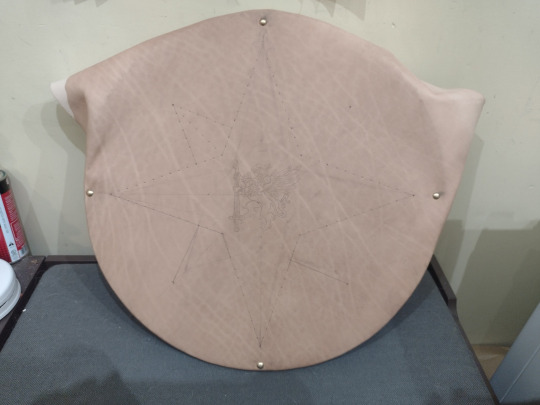

With the leather dried it's much easier to see the layout lines. Here's a spot I can make some big improvements on next time: I attached the leather before trimming it to a proper round, and then I didn't fully tack down the back before beginning the layout process. The wood I used was pretty trashy plywood so my drawing and carving surface is also extremely bumpy underneath the leather.
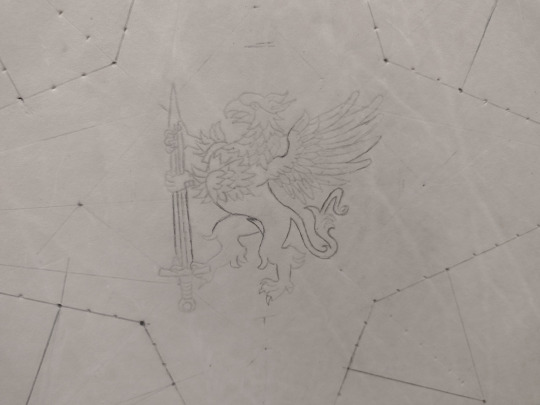
At this stage I began to carve the central award badge with my swivel knife. I need to see if there's swivel knives for children with arthritis because my bog standard Tandy knife gives me hella hand cramps and extreme inflammation on my thumb-palm muscles.
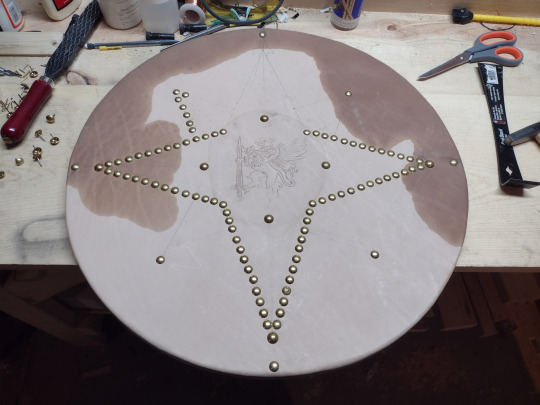
Your eyes do not deceive you: I did in fact have a crisis of attention span and pivoted from carving the badge to outlining the compass rose in brass tacks. The majority of the tacks used for this project are 7/16" low dome brass tacks from Crazy Crow Trading Post down in Texas. I also used 1/2" high dome and 1/4" dome tacks from the same shop.


Lining up the 1/4" tacks. I actually hadn't planned to do these lines initially, but I had to emergency order more tacks and tossed these in for greater variety. I love the end result of this decision. If you tuckered out your arm hammering in 2/3 of the outline tacks with a ball peen, a drill press can take over in a pinch. I really need to get a stool for the drill press.
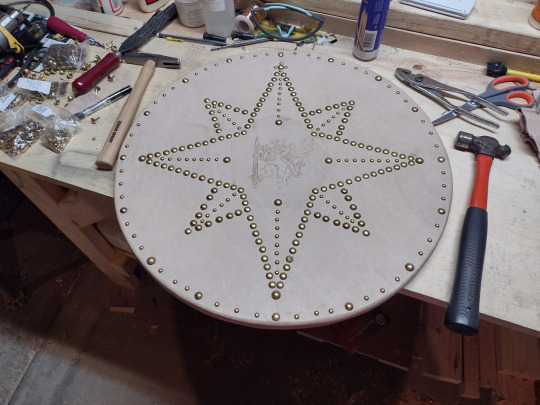
Tacks complete! We can carve again now.
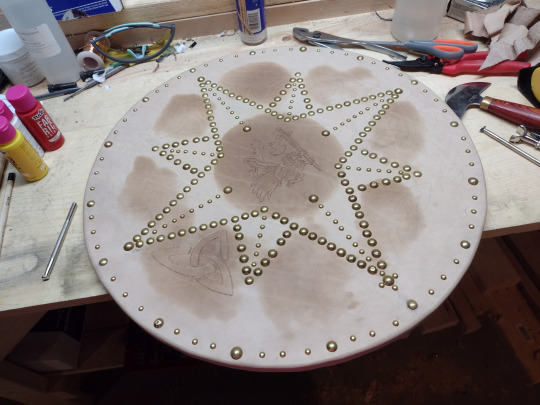
Added some obligatory trinity knots. It's not Scottish if it doesn't have a triskelion or a trinity knot, dontcha know?

(Sarcasm aside, check out the targe used by Donald Cameron of Lochiel, the Cameron Clan Chief who was a prominent Jacobite commander throughout the 1745 campaign. Post period for the SCA but who's counting? Photo from Paul Macdonald of Macdonald Armories in Scotland.)
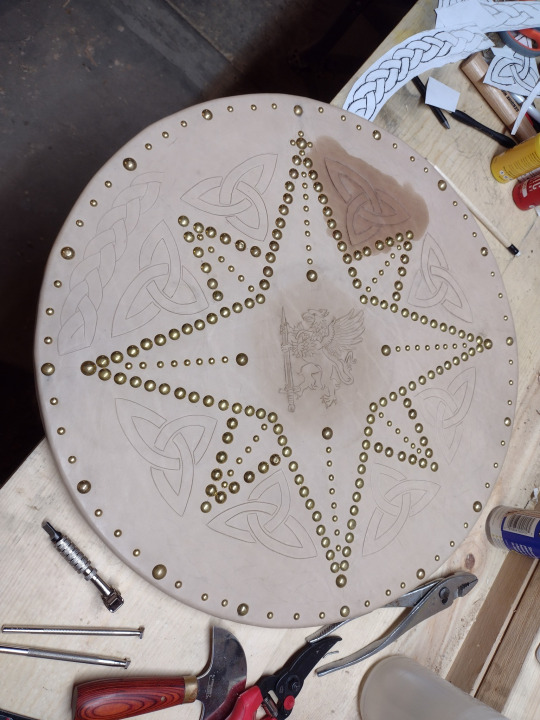
All trinity knots cut, one carved, and I began to add a braid motif too.

...Aaaaand here's improvement opportunity number 2. I was low on time and hand strength so I decided to dye the leather before I carved the braids, but after I cut them. I also picked Fibbings Medium Brown for my dye without doing test patches, and used the standard daubers to apply it. That is three Big Mistakes in a row, and only one is actually justifiable in any way. The result is an extremely uneven dye job that completely washes out the uncarved braids. If I'd given myself one more week to do this scroll, I would've had more rest time for my hands and I think I wouldn't have made these mistakes, but in a way I'm grateful I did because now I know to schedule more time for working on scrolls for the next assignment. Plus, I try to remember what Samii of SunCat Designs says about art: "the mistakes are what make it human".

Because this is an SCA award, I chose to swap the traditional deerhide backing for glued muslin and paint. I then taped off my handle locations and handed it off to my spouse @dustycymbre for the award scroll text. They used their default uncial hand, which is my favorite of their script hands.
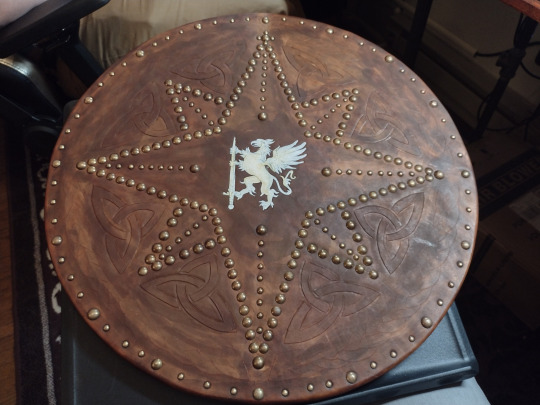
Traditional targes have a small brass center boss. When I originally conceived of this award, I had imagined the griffin in brass with a tinned sword, but I haven't actually tried chase and repousse yet and struck upon a different method of making the center griffin allude visually to the center bosses: carve it directly into the leather and then gild it. This particular stage is sealing the carving with Ecoflow Cova Color leather paint, to provide a smooth surface for the glue (also know as gild size).
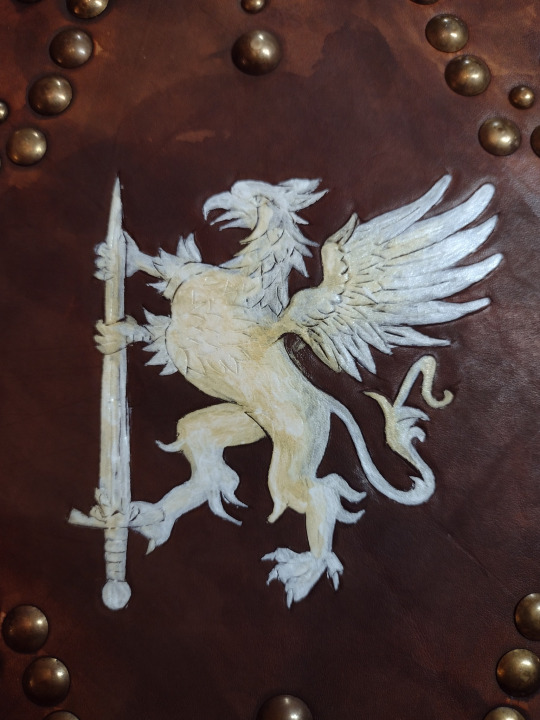
Cova Color white shouldn't be directly applied to damp dyed leather like this because it soaks up the brown like a sponge. My brightest white application is my H-shield, which dried for about a week before I painted it.

Another ADHD swing of focus: needed to have a long phone conversation with my spouse and bro in law and stitching is a far less active hand activity for me than The Thing I've Never Done Before, so I stitched up the strap and handle. Here the handle is inside out in a jar of water to get nice and soft for turning.
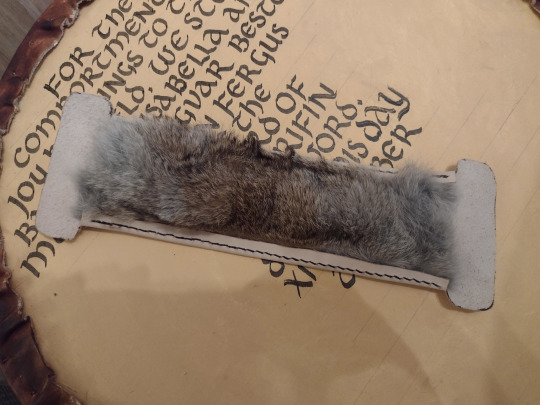

I stitched a rabbit hide into the interior of the arm strap. It's soft and a little padded, and I think it looks quite fetching. To figure out the right strap length for the recipient's ridiculously beefy arm that helped him earn this award, I asked my former football player bro in law for his arm circumference and then rooted around the house for a pickel jar of the same diameter. Stitch width awls are your friend. One of the top ten tools I own for sure.

Turning out the handle. This took a lot of hand strength and chopstick finagling. I'm genuinely looking forward to making Kat the Herald's purple shoes because they'll be easier to turn than this fucker.
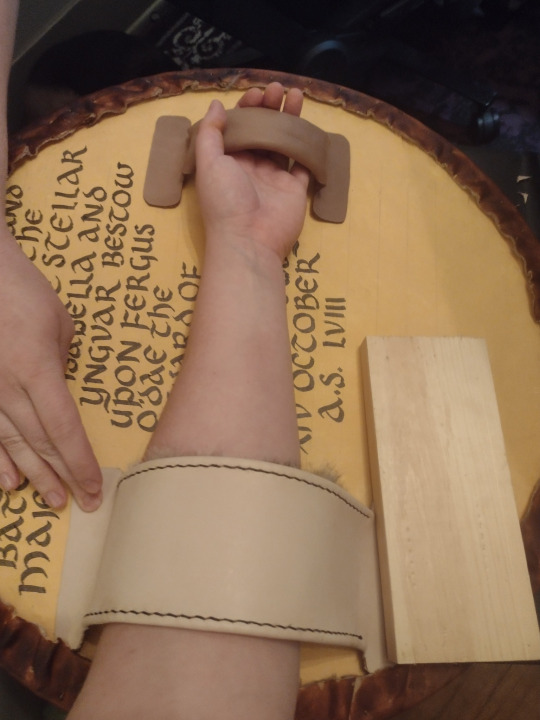
Fit check. Look at that beautiful wet shaping on the handle! At this point I felt a level of actual mastery of my craft. I think I can really call myself a leatherworker now. I still have so much to learn and improve, but I feel comfortable. It feels good.

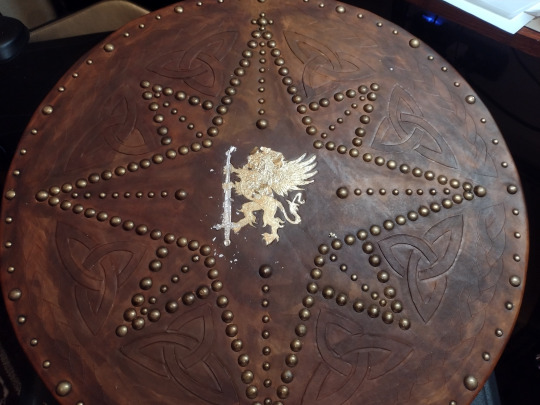
With the handles done, it's back to gilding. According to the Pinterest mommy blogs, you can skip the professional artist size and use watered down mod podge for the gilding process. I gambled on them being right, whipped out my pack of silver, copper and gold foils, and got down to business. I used a tiny but cheap paint brush to apply the thinned glue to the sword, let it dry a little, and then applied the silver foil. I tapped at it with a napkin through a flour sack towel, let it dry a little and brushed off the excess with a second and much fluffier brush.
The Pinterest pinnsters aren't entirely wrong about mod podge, but they aren't entirely right either. I had to add more glue and gilding foil like eight times. This is after one of the last additions, but before I brushed away the excess. Mod podge doesn't want to work on the irregular curves of carved leather. The dry time to tackiness was also imprecise and very very short, which made applying the delicate foil correctly very difficult.

I finally had to give up. There were just too many spots that would not take foil at all. I grabbed my Stewart Semple Heavy Metals box set, pulled out the Goldest Gold, and painted over the bare spots. At this angle, the difference in reflection angles and quality is obvious. The paint is so much more yellow. But deadlines are deadlines, and imperfections make it human.
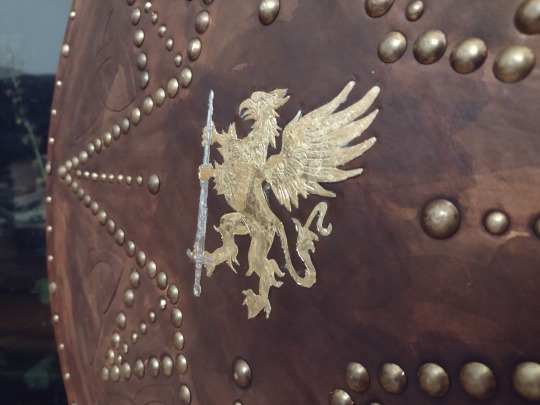
This angle is much more favorable. I find myself in love with the effect of the gilding over the carving on the feathers. I need to get good at gilding.
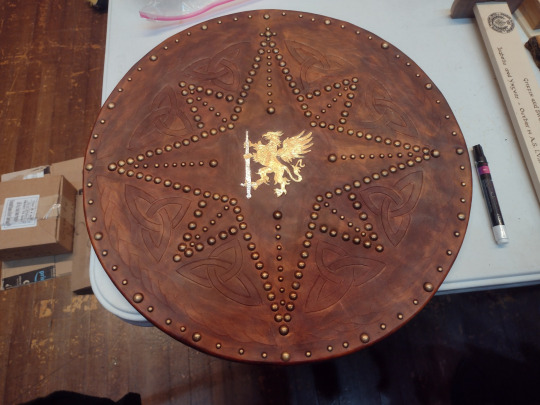

And here she is signed by Their Majesties Northshield, in the warm lights of the Sioux Falls Coliseum stage. Fergus loves it and it got a lot of ooos and ahs from the populace. I had a lot of fun in spite of some of the frustrations of this build, and I'm excited to try another targe with even more accuracy at some point.
#sca#society of creative anachronism#my crafts#reenactment#scottish#scotland#targe#did you know that certain jacobite targes made of softwood with wool felt sandwiched inside the wood core can stop musket shots#i learned that from fandabi dozi and paul macdonald#they tested it mythbusters style
17 notes
·
View notes
Note
omg immortal soap
what if he's been around for a while and is proficient with swords
imagine him wielding a claymore
Anon you’re so incredibly right, that man was made to have a broadsword in his hands (bonus points for a full kilt ensemble too)
And, because I am a history major (and a research nerd to boot), here are a couple of quotes from Arthur Herman’s book, How the Scots Invented the Modern World:
“As Dr. Johnson observed, in the Highlands ‘every man was a soldier.’ The clansman was trained to fight from boyhood. Armed with his double-edged broadsword, which measured a yard long and two inches wide; his dagger or dirk; and his shield or targe, and screaming his clan’s motto as he rushed headlong at his opponent, he was a formidable sight. But he was no Iron Age throwback, the ‘bare-arsed banditti’ of English legend. He could be as familiar with handling a musket, and fighting in formation, as any British grenadier. For generations the principal export of the Highlands had been its surplus males, as soldiers and mercenaries for the armies of Europe. In the Middle Ages, Irish chieftains had hired them: nicknamed galloglasses or redshanks because of their exposed knees below their kilts, Scottish mercenaries had kept the Gaelic parts of Ireland safe from the English for four hundred years… ‘They are formidable fellows… They are all gentlemen, will take no affront from any man, and insolent to the last degree.’” (pgs 128-129).
“Once again, British cavalry and infantry flew into a panic as the Highlanders attacked… ‘Men accustomed only to exchange bullets at a distance… are discouraged and amazed when they find themselves encountered hand to hand, and catch the gleam of steel flashing in their faces’” (pg 149).
That’s the immortal Johnny I picture, especially if he and Simon meet on the battlefield, Scottish mercenary against English soldier. Simon has never given much thought to the Highlanders beyond the usual English disdain, but when he meets Johnny on the battlefield, all righteous anger and blazing passion, a broadsword in his face and a rattling war cry echoing in his ears, he knows that he’d gladly let Johnny kill him if only to have the honor of dying at his hand
Isn’t it fortuitous, then, that Johnny is waiting by his side when he wakes up hours later, a decent meal and an explanation waiting for him, because Johnny’s been around for at least three hundred years and he’s really fucking tired of going it alone (if the universe decides to dump some self-righteous Manc on him… well, he’s done more with less, and he’s sure he can crack that hard shell sooner rather than later)
As a side note, I highly recommend the book that those quotes come from, it’s a fascinating look into the origins of Scotland, its culture, and its people. It touches a lot on Scotland’s historical ties to England and the rest of the world from the 1500s on. The author is a distinguished historian (so he knows what he’s talking about) and it’s truly an enlightening read (and has taught me a lot about our favorite sudsy sergeant 🏴)
#call of duty#cod#john soap mactavish#simon ghost riley#ghoap#ghostsoap#soapghost#tombstone's epitaphs#tombstone talks#immortal 141 au
78 notes
·
View notes
Text
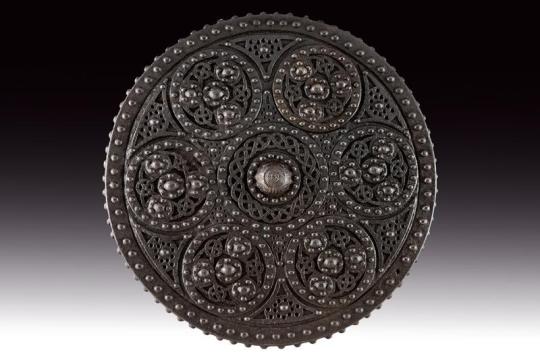
Scottish targe (small shield), 18th century
from Czerny's International Auction House
94 notes
·
View notes
Text
“Tallgeese”: Why Is It Called That?
Okay, so, I have a theory.
Bear with me a moment. As far as I know, I’m the only person who thinks this might be the reason why the Tallgeese is called Tallgeese; I don’t know if it’s the RIGHT reason, but at least it's an explanation I think is etymologically and contextually feasible:

--If I may draw your attention to my man Tallgeese’s shield for a moment: you will see that it is a small, round buckler. Tallgeese is styled with a very fetching crest reminiscent of a Greek hoplite, and hoplites did indeed carry a round shield called an aspis.

(Image from the Harvard collection)
However! There is another kind of small, round shield that was used in less ancient times called a targe, or targa, or the diminutive target, where we get the word “target" from. The targe was a shield used largely for jousting and dueling– something the Tallgeese excels at!
When full plate armor was developed around the late 14th century, knights switched from using large, triangular shields, to the smaller and variously shaped targe shields, specifically for the sport of jousting¹. If you're looking at shields from medieval Europe in a museum you'll see a lot of fancy-shaped ones labeled targes.
Much later, it became synonymous with the Scottish targe, which is a regular combat shield and not a jousting shield, but it shares the same name and more importantly, is a small, round buckler typically used with a sword-- like the Tallgeese uses!
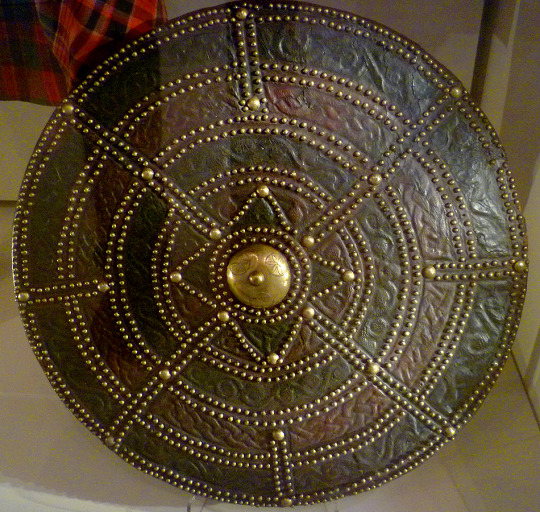
(A Highland targe exhibited in the National Museum of Scotland)
--Which leads me to my main point:
If you were looking up cool words for round or otherwise knightly shields, you might well come across the word “targe”. And if you pass the word “targe”(especially if you pronounce the final ‘e’) or “targes” through a Japanese phonetic filter, you might well get something close to “Tōrugisu” (トールギス), which is the name of our mobile suit.
…It might not be the canonical explanation for the Tallgeese’s name (to the best of my knowledge, there isn’t one²) but at least it’s slightly more relevant to its theming than is a waterfowl of alarming height-- though perhaps only a tenth as horrifying on the field of battle.
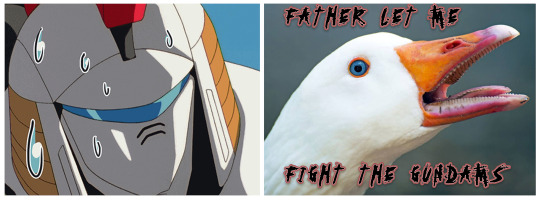
...Still I hear it in my dreams; the fell slapping of orange feet, the distant honk, the snapping beak...
________________
1) "The Seven Shields of Behaim: New Evidence": Metropolitan Museum Journal, v. 30, Nickel, Helmut (1995)
2) The Gundam Fan Wiki states in its Trivia section that: “The name Tallgeese is derived from the word "theurgist" (トールギスト), a ritualist who attempts to channel divine power to work miracles”. This is apparently from one of the SD Gundam games? Anyway, I find this source to be INCREDIBLY DUBIOUS.
102 notes
·
View notes
Text




September 9th 1513 was a sad day for us Scots, we lost our King and thousands more fellow countryman at The Battle of Flodden.
The Battle of Flodden Field was undoubtedly the most famous confrontation between the English and Scots ever fought on English soil. It took place eight miles to the north west of Wooler near the village of Branxton, Northumberland.
The year before sought to renew the ‘auld alliance’ and assist the French by invading northern England, should England wage war on France, which they duly did.
Money and arms were sent to Scotland from France in the following months enabling King James to build up an army for a large scale invasion of England. On the 22nd of August a great Scottish army under King James IV crossed the border.
For the moment the earl of Surrey (who in King Henry ViII.’s absence was charged with the defence of the realm) had no organized force in the north of England, but James wasted much precious time among the border castles, and when Surrey appeared at Wooler, with an army equal in strength to his own.
Now I don't know how accurate this description is so don't shoot me, but it does have a feel of authenticity, it is from Robert White who describes the Scots army, in the Cambridge History of the Renaissance: “The principal leaders and men at arms were mounted on able horses; the Border prickers rode those of less size, but remarkably active. Those wore mail, chiefly of plate, from head to heel; that of the higher ranks being wrought and polished with great elegance, while the Borderers had armour of a very light description. All the others were on foot, and the burgesses of the towns wore what was called white armour, consisting of steel cap, gorget and mail brightly burnished, fitting gracefully to the body, and covering limbs and hands. The yeomen or peasantry had the sallat or iron cap, the hauberk or place jack, formed of thin flat pieces of iron quilted below leather or linen, which covered the legs and arms, and they had gloves likewise. The Highlanders were not so well defended by armour, though the chiefs were partly armed like their southern brethren, retaining, however, the eagle’s feather in the bonnet, and wearing, like their followers, the tartan and the belted plaid. Almost every soldier had a large shield or target for defence, and wore the white cross of Saint Andrew, either on his breast or some other prominent place. The offensive arms were the spear five yards in length, the long pike, the mace or mallet, two-handed and other swords, the dagger, the knife, the bow and sheaf of arrows; while the Danish axe, with a broad flat spike on the opposite side to the edge, was peculiar to the Islemen, and the studded targe to the Highlanders.”
The English commander promptly sent in a challenge to a pitched battle, at Millfield, an area of flat ground three miles north of Wooller, which the king, in spite of the advice of his most trusted counsellors, accepted.
On the 6th of September, however, he instead took up a strong position facing south, on Flodden Edge. Surrey was unhappy for the alleged breach of chivalry. This was at the end of the medieval period, I have pointed out before, battles, in the main, were fought to a code, breaches of which were rare,and so it was a second challenge to fight on Millfield Plain was sent. When Surrey’s herald arrived at the Scottish camp, James refused to meet him and instead sent word that he would not be dictated to by a ‘mere Earl’.
The English commander, at 70 years old was a veteran of many campaigns, then executed a daring and skilful march round the enemy’s flank, and on the 9th drew up for battle in rear of the hostile army.
It is evident that Surrey was confident of victory, for he placed his own army, not less than the enemy, in a position where defeat would involve utter ruin. On his appearance the Scots hastily changed front and took post on Branxton Hill’, facing north. The battle began around 4pm and Surrey’s archers and cannon soon gained the upper hand, the Scots, unable quietly to endure their losses, rushed to close quarters. Their left wing drove the English back, but their reserve corps restored the fight on the auld enemies side.
In all other parts of the field, save where James and Surrey were personally opposed, the English , gradually gained ground. The king’s corps was then attacked by Surrey in front, and by Sir Edward Stanley in flank. As the Scots were forced back, a part of the English reserve force closed upon the other flank, and finally charging in upon the rear of King James’s corps. Surrounded and attacked on all sides, this, the remnant of the invading army, was doomed. The circle of spearmen around the king grew less and less, and in the end James and a few of his nobles were alone left standing. Soon they too died, fighting to the last man.
Among the ten thousand Scottish dead were all the leading men in the kingdom of Scotland, and there was no family of importance that had not lost a member in this great disaster. The “King’s Stone,” said to mark the spot where James was killed, is at some distance from the actual battlefield.
Scottish dead included twelve earls, fifteen lords, many clan chiefs an archbishop and above all King James himself. It is said that every great family in Scotland mourned the loss of someone at the Battle Of Flodden. The dead were remembered in the famous Scottish pipe tune The Flooers o the Forest.
Here is a partial list of those that died, those that know even just a wee bit of our history, through my posts, will recognise the names, if not of the actual knights themselves, but the families that have played such a part in our history.
Sir George Seton, 3rd Lord Seton Sir John Hay, 2nd Lord Hay of Yester George Douglas, Master of Angus Sir David Kennedy, Lord Kennedy and 1st Earl of Cassilis Sir William Graham, 1st Earl of Montrose Sir John Stewart, 2nd Earl of Atholl Sir William Leslie, 3rd Earl of Rothes Sir Archibald Campbell, 2d Earl of Argyll Patrick Buchanan, 16th Chief of Clan Buchanan Sir Robert Erskine, 4th Lord Erskine Sir John Somerville of Cambusnethan John Murray, Laird of Blackbarony Robert Colville, Laird of Hiltoun Sir Matthew Stewart, 2nd Earl of Lennox.
Add to theT, most of their Eelder sons were slain, what is extraordinary though, that of this wee snapshot, none of the lines ended, so there must have been plenty more offspring in Scotland! Let's not forget the thousands of ordinary Scottish soldiers that died on the battlefield that day.
You can read a more detailed account here https://www.britishbattles.com/anglo.../battle-of-flodden/
15 notes
·
View notes
Text


Minisa Whent-Tully
The Whents are such a fun house, they live in a HAUNTED CASTLE and their sigil is a BAT. The Whents are vampires headcanon confirmed (there's a Lady Stoneheart vampire theory here somewhere) .
I didn't really want to portray Minisa as sweet or diminutive. I can't see anyone who grew up in Harrenhall of all places to not have some fangs. You can be a beloved wife and mother and also be creepy AF.
The Riverlands pre-rebellion to me are the epitome of Post-Roman Pre-Anglo Saxon fashion in the Scottish isles. Gallic influences mingling with drapery, rich dyes, and fine metalwork. Post-Rebellion, there's less of an anti-Targ backlash style-wise, simply because there's less of a stark (ha) difference between the Riverlands and KL. Nobles begin to prefer less draping in favour of tighter tailoring and heavier embroidery, but that's about it.
I feel like if anyone would preserve a stylistic time capsule like Druidic face paint for centuries after the conquest, it would be vassal houses surrounding a superstitious and mystical place like Harrenhall.
Rickard-Lyarra Brandon Ned Lyanna Benjen Jon Arya
Minisa Hoster Catelyn Edmure Lysa Robb Sansa Bran Rickon Robin
#asoiaf#valyrianscrolls#minisa tully#minisa whent#game of thrones#got#house tully#house whent#i made a riverlands background! its not that great but i kind of regret not doing one for the previous characters
55 notes
·
View notes
Note
least fave asoiaf name?
Oh My God there's so many split between 'this sounds gross', 'this pisses me, an insane etymologist enthusiast, off'
SOUNDS GROSS: bennifer (like the fucking celeb portmanteau??), gaemon (ugliest targ name. naming my baby gayman), aenys (bruh.), dake (.bruh), hobber (mina tyrell why did u name ur kid this.), gargon (sounds like when my 10yo brother tries to do a dragon deez nuts across your face joke), garse(ok this one and hobber are supposed to sound gross but cmon bro)
PISSES ME OFF EYTYMOLOGICALLY: patricia, henrietta, isembard, christian-derived names like josua, criston, joseth. he has a bunch of surnames (usually scottish) used as names which is a common practice in the USA but sounds weird in a medieval setting eg cameron, kyle, qarlton
FRAT GUY QUICK ROUND (names that i dont necessarily hate but make me go lmao thats a westerosi frat guy): bradamar, braxton, addison, ambrode, chett, gareth, harys, josua, joseth, kevan, kyle (so many kyles omg), malentine, raylon ok ill stop there its no longer a quick roung
thats just off the top of my head plus quick browse of The Spreadsheet im sure theres more i have opinions on!
#i dont hate any irl names i think all names are beautiful. except the american protestant suburbian scots-irish nightmare names#all the variants on aiden etc. but other than that i think all names are beautiful because humanity is beautiful and language is beautiful#ask#anonymous#this is so messily formatted my bad bro
15 notes
·
View notes
Text
Ferenir's shield is actually not too large. It's around the size of the Scottish targe, a round small-ish shield, although it's made of steel.
Too large shields offer a lot in terms of defense, but they also severely limit offensive ability and maneuverability. Which is completely fine in war and a formation, because that's your job, to defend, while the spearmen behind you stab over your shoulder.
But in a solo situations, just defending is not enough, you cant have a shield that limits your offensive options. Instead the shield must be able to be part of them.
That's why smaller, round shields (or dedicated 'bashing' shields for that matter) are much more prefered in those situations. The shield isn't there to 'block', but to parry, deflect, create openings, and very importantly, BASH your opponent with it.
And not the useless video game bash with the flat, but the 'punch the enemy with the side of the shield' one. Unless you got a massive spike on the flat, at least.
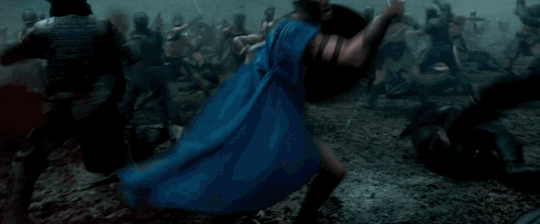
A large shield is also a massive pain in the ass to carry around. Which is extremely important in not hating your life every time you try to function as a normal person.
For these reasons, Ferenir has opted for a smaller shield that he uses mostly for parrying and bashing.
3 notes
·
View notes
Text
Capítulo Once: I’m A Monster
Deep within the forest, I pursue my prey. Stalking a pulchritudinous pair of teenage lovers, who appeared to be in middle school, as they walk down a trail in the dead of night searching for a ghostly fright.
Despite my following them, these two lovebirds were not my target. Rather, they were unwitting bait for my prey—an otherworldly intelligence, not from the stars, which relishes human flesh for various purposes. Sometimes to eat, sometimes for the same reason people have tortured baby monkeys or kittens, and other times for sadistic sexual gratification. Not that these three motivations were mutually exclusive.
I had my attire modeled as a sort of medieval interpretation of a Kamen Rider. A round helmet with oni-like horns and a third eye painted on it. The visor combining elements of a bug’s and human’s eyes, with an ovular concave shape segmented into a pupil and iris without a sclera. Additionally, a pointed strip of metal extended outwards from the edge of the visor.
Covering my face was a menpō (面頬) depicting an open smile with exaggerated mandibular and maxillary fangs, giving me a predatory expression. To protect my neck, albeit at the expense of restricting its movements, I wore a bevor.
The breastplate accentuated my bust with the kanji for “super” (超) painted on the center of the chestplate and below the clavicle. Spaulders, rondels, couters with a weaponized point on the elbows, and vambraces protected my arms. I also wore gauntlets with talon-like tips.
At my hips, I had three overlapping tassets on each side. For my legs, I donned cuisses, genouillères, shin-guards, calf-guards, and segmented sabatons, which provided greater freedom of movement.
The weapon in my hand was Ryūseiseki (流星石), a kanabō made of carbon nanotube reinforced tungsten with meteoric iron studs. The pommel of Ryūseiseki could detach to reveal the spine sheathed within the handle, which I named Tenbatsubari (天罰針).
The meteoric iron (隕鉄) within these studs had been alchemically transmuted into a cold iron (冷鉄) alloy. An alloy that disrupts the flow of magical energies of the beings from Otherworld (異界).
Affixed to my utility belt was a kpinga, a five-bladed weapon meant for melee combat or to be thrown as a shield-circumventing fūma shuriken (風魔手裏剣). A weapon I named Hiraiha (飛来刃).
From the handle projected a main bladed shaft, which split into two counterclockwise carvers. These carvers extended from the stem’s ten and two o’clock positions and were crooked at an almost ninety-degree angle in a counterclockwise fashion. A third counterclockwise curved, but not crooked, blade extended from the base of the main shaft at the weapon’s three o’clock.
Unlike a traditional Azande kpinga, the basic design of which the bladesmith emulated, its form took inspiration from the Chinese hook sword, or gōu (鈎). Hiraiha featured a crescent, single-edged guard to protect the handle, which was wrapped in goat skin leather for a more ergonomic grip. This weapon projected a dagger-like blade at the end of its hilt to facilitate slashing and stabbing.
My shield, Kyūdōmujun (九瞳矛盾), was another weapon of hybrid consideration. Inspired by the spiked pavise of medieval Europe, with a shovel-like blade that allowed it to be planted in the ground or used to augment my punch. Kyūdōmujun also possessed a tungsten spine modeled after those of the Scottish targe. This allowed me to gore my enemies if I gripped the shield with my fist. This weapon’s name drew from the ocular motive painted across its face: eight eyes circumscribing another massive central eye out of which extended the tungsten spine.
I had heard a rumor about something that should not be here. Something like the excoriated corpse of a beheaded, eight-armed giantess grafted, from the hips up, onto a flayed horse as tall as a giraffe at the shoulder. Its eyes were like a blazing fire, its breath a potent miasma, and it wielded a flanged mace in each hand. A devil whose wail could strip the courage from a samurai.
This is what the locals called the Ama-uma (海人馬): a cryptid blamed for the exceedingly cruel deaths of over ten people, not counting the alleged suicides. I suspect that it was also responsible for the astonishingly gruesome deaths of a hane no haeta kappa (羽之生えた河童) and a shirogitsune (白狐).
What I would find today, however, was not some misplaced Indo-European chimera, but something native to the folklore of this country. I could feel its presence through the tactile hairs across my skin as its evil presence filled this space.
The chill of the air forebodes something truly monstrous. The electricity coursing from my shoulders to my brain, tempting me to a shudder that I successfully suppressed. There was a magical power flowing through the ever-thickening air as it approached.
I heard, with bat-like hearing, the violent chattering of teeth and rattling of bone against bone in the distance, which strangely grew less intense as it approached. Owl-like night vision allowed me to see into the darkness, in search of the evil spirit, as the pair grew more and more disturbed by the approaching aura they could only indirectly sense.
A smell of rotting human flesh in the distance detectable through my canine olfaction.
It accidentally made a sound as it stepped on an unnoticed branch, so they turned to see it. From a distance, it bore the appearance of a defleshed human skeleton held together only by tendons, except it was far too big to have ever belonged to a man. Ever-hateful bones animated by a ghost with insatiable hunger and unquenchable thirst.
Though, upon closer inspection, one could see an ancient magic carved into every bone of that fifteen-meter-tall monster, with a script I could not read.
The boy, as would be proper of a man, stepped between the monster and his girlfriend, who froze in supernatural terror. Curdled blood stained its hands and jaws, with bits of putrid maggot-infested flesh clinging to its hideous, triangular, and chiseled incisors.
That’s when it made its move, and I sprang into action. Leaping with the force of a bomb detonating below my feet, I launched 30 m into the air. I threw Ryūseiseki, which exploded through the monster’s wrist like a bullet through glass, and punched straight through into the ground. This violently forced the carpal bones apart and forced the monster to drop them.
I grabbed the humans, using a seminal power to fly and dampen the inertial forces experienced as I landed. A landing that started in a run and ended in a slide across the ground. I place the two on their feet, and they saw my mask.
I stepped between them and the gashadokuro (餓者髑髏), which emanated an overwhelming and penetrating psychic field to immobilize its prey. So, I expanded my psychic influence to oppose that of the gashadokuro and release the youths from its paralyzing presence.
Having freed them from its telepathic oppression, I told them simply, “Run!” as I grabbed Hiraiha. The boy thanked me as they took off, but the man-eater, ignoring me, reached for them.
“Oh, no you don’t, you bastard!” I told this malevolent intelligence.
“You won’t be gnawing on the bones of children today!”
I once more leaped with explosive force into the air. This time, aiming at the base of the giant’s skull from under and through the space between the mandible. I punched a hole into its skull with my shield’s spine, pushing those loathly bones away from the naïve lovers.
As they ran, the young woman looked back and saw that I decomposed my body into a superheated smoke. I caused it to rapidly seep into the cranium through the foramen magnum of the staggered titan. This forced the air within out through its many lesser foramen and fissures, as well as the puncture wound I had just made.
I reconstituted myself inside the braincase in the fetal position since its skull was only 122 cm tall. So, I summoned my metal shearing strength. Pressing on all sides with my limbs and body until the cranium lost structural integrity on all sides, killing it instantly.
I rotated like a cat in freefall, then landed on all fours like a monkey, having avoided injuring myself upon these criminal bones. Quickly, I moved to recover Ryūseiseki from its burial place, gathered the rest of my equipment.
Then, I made my way over to the femur—the strongest bone in the gashadokuro’s body—and cut away its tendons with Hiraiha. I thought I could carve an excellent weapon, fit for an oni, from this material.
Unlike the lovers under my aegis, I’ve always known of the existence of monsters simply because I am one. My name is Setagaya Momo (世田谷 桃), and what I am goes by many names across the world: Yāo (妖), Goemul (괴물), Wenkamuy (ウェンカムィ), and Faerie, but here in Japan most people would rightly call me a Yōkai (妖怪). I am not a metahuman. In fact, I am not human at all. My biological father was half-succubus and half-vampire, whereas my biological mother was a half-oni and half-djinn. They died when I was only a few months old, and that’s what resulted in my adoption by a kindhearted couple who found me abandoned in the woods. My adoptive father was a foreign-born Yamato man, and my adoptive mother an Ainu from Hokkaido. From my adoptive metahuman parents, I inherited the siddhis of Earthly metahumans, with my unique power allowing me to unite the powers of my parents while assimilating none of their weaknesses, and that included the seminal powers of humanity: my adoptive heritage.
To protect the human nature that loved me when I was weak and powerless, I took on the guise of their archetypal superheroes, such as Ultraman, to fight against the unspeakable evils that come from Otherworld. Though, I also dabbled in vigilantism.
I thought that something had to have happened in Otherworld, as I had never seen something of this scale pass through the veil into the Human World (人間界). Considering that I had never been to Otherworld myself, I did not know what it might be.
As I walked around the corpse, contemplating how to conceal the bones, I heard something behind me in the distance. I turned around and noticed a massive, hideous thing with gray skin, knee-length wavy locks, a long, broad, drooping nose, piercing eyes, long, pointed, drooping ears, and disproportionately small head compared to their muscularly rotund body, legs, and arms appeared from within the woods. I had never seen this manner of yōkai before, so I grabbed Hiraiha and prepared for a fight.
But the monster calmly pleaded, “Easy, demon slayer! I mean no harm.”
Another, higher-pitched voice confirmed this, “It’s true, he saved me from slavers!”
A human girl, only nine years old, stepped out from behind him. A Koropokguru (コㇿポックㇽ), which resembles a bearded Ainu man, except that he was small enough to effortlessly hide underneath the leaf of a butterbur, stood on the child’s left shoulder.
The Koropokguru petitioned, “All we ask is that you hear us out.”
This child was clearly not a native to this location. Evidenced by her red hair, green eyes, and fair skin. I could smell the humanity coming from her, and the way she clung to the troll’s robes told me that the child felt safe with this stranger, so I deigned to trust this foreigner.
I holstered my weapons and asked it, “What manner of yōkai are you?”
The thing explained with a bow, “I am but a humble troll (トロール), but you can call me Hallvarðr (ハルヴァーズル).”
A strange name that I could not hope to pronounce, so I avoided using it. That said, he was astonishingly proficient in Japanese.
The Koropokguru introduced themselves with a bow. “My name is Atuy (アト゚イ).”
I could speak and understand Ainu, so his name was easy for me to pronounce and remember.
The child did not deign to speak, but she emulated her guardians.
I warned him, “A troll? By earth or Otherworld, you have traveled far. But make no mistake. I am protector of this island, and if I have any inkling that you mean harm to men, I will waste no time in swiftly ending your life.”
The child seemed to understand the general threat, as she clung even tighter to the troll, who reached into his shirt and revealed a crucifix necklace, explaining, “I commend your love of humanity, but as you can see, my God is a man, so I mean men no harm.”
This took me aback. I had heard stories of yōkai being converted to Catholicism in Medieval Europe, not dissimilar to the stories of yōkai converting to Islam and Buddhism throughout Africa and Asia, but I had so few interactions with my race that I had never seen this myself.
His voice was as deep and powerful as you might expect from a 350 cm tall humanoid who looked as if he could wrestle a bear into submission, even without magic, but it was soft enough as to not frighten the girl, whom he comforted with a gentle head pat.
The monstrous thing said, “I apologize for the fright, but we had heard the rumor of a monster slayer with tremendous power, so we seek your aid.”
Atuy explained, “Several man-eaters have escaped Otherworld and entered Earth through a doorway on this island.”
The Troll explained, “It is not just here. Portals have appeared across the Human World.”
Atuy asked, “Have you noticed something unusual about the anthropophagi recently?”
My thoughts turned to the alien description of the Ama-uma and the unexpected state of the gashadokuro’s teeth, which are not traditionally reported to be filed, as well as its joints, which I would not have expected to possess tendons.
I honestly answered, “Yes, there are reports of a monster wondering about this country, which does not match the description of any native to the local mythology.”
The Troll asked me, “I thought so. Could you please describe this criminal?”
I complied. “A yōkai, called Ama-uma, which is implicated in multiple murders. It has the form of a woman, from the hips up, grafted onto a horse…”
I could see that the Troll immediately recognized this description, and I asked, “So you know what this is?”
He told me, “It sounds like a Nuckelavee (ナックラヴィー). An unusual devil for this part of the world…”
I interrupted, “That’s what I would have assumed if it wasn’t headless with additional arms.”
The Troll seemed troubled by this revelation, turning to Atuy. They seemed to be on the same page, so the troll explained, “I am unfamiliar with this criminal, but we will help however we can.”
I asked him, “I assume you are in pursuit of a specific monster?”
The Troll admitted, “Yes. We have tracked many devils who have tried to enter the human world: manticores (マンティコア), yara-ma-yha-who (ヤラマヤフー), even asuras (阿修羅), but we’re currently looking for a hanyō (半妖) who was born and raised in Otherworld.”
My left hand could not help but flinch when he said that their target was half-human. Because of my assortment of powers, I had never had to kill humans in my vigilante work. Even the yakuza were of little concern to me, given I could simply transmute my body into and from various amorphous states.
That, coupled with the power to enter people’s dreams, to shapeshift into animals, become invisible, and to hypnotize the weak willed with eye-contact, among other powers, meant that I’ve never had to take a human life.
I’ve only met one other hanyō in my life, a sweet little girl only twelve-years-old who was half-Sotonarukami (半外なる神) and I could not imagine seeing her as anything other than a metahuman, like my parents.
Atuy admitted, “We know next to nothing about our target, except that they are an astonishingly powerful necromancer and follower of the Devil Path (魔道).”
Without moving my feet, I turned to look at the aberrant gashadokuro, and the Troll asked me, “Do you think that this necromancer might have something to do with this devil?”
I turned to face them and admitted, “It’s possible…”
But before I could finish my thought, a flash of light illuminated the distant north behind me. I turned to look toward the flash, which left the others in confusion.
A few moments passed before the troll observed, “I am not familiar with how the weather in the Human World works, but I thought a particular cloud was necessary for lightning. Yet the skies are clear.”
I chimed in, “That is my understanding as well…”
We waited for a little before I rhetorically asked, “Where’s the thunder?”
Atuy agreed, “It is oddly silent.”
I pointed out, “From what little I understand about the matter, I remember humans can only hear thunder up to about sixteen kilometers from the lightning strike. That means the young girl should have heard the clap of thunder within 47 seconds.”
There was a foreboding feeling that overcame me, something that the others felt through my aura and saw through my body language.
The troll revealed, “I feel an intense psychic disturbance, the likes of which I have never felt before.”
I felt it as well, coming from that direction, but aside from an intense sense of forewarning, I had no intuition what this might have been.
I asked them, “What was the most powerful devil that you know has crossed the veil into the Human world?”
The troll told me, “That would probably be an asura, but we believe she arrived in Patagonia, not Japan.”
I asked them, “What other devils do you suspect have made it here?”
The troll confessed, “I believe that a manananggal (マナナンガル), mapinguari (マピングヮリ), and nue (鵺) have made their way into this country.”
I did not recognize the term mapinguari, but the others I have heard of, and while they were incredibly dangerous and sadistic creatures, none could explain what it was we observed.
After about four minutes, we all heard a crack of thunder succeeding it. Loud enough that we could feel a wall of pressure pass over us, jostling our hair, the troll’s clothes, and throwing poor Atuy off his feet. He held onto the child by her hair, who didn’t mind while she clung to the troll, not out of a need for stability, but for a sense of protection. As Atuy climbed back up to his shoulder, we all spotted the cloud rising in the distance.
A cloud that soon took on a familiar shape, clear to the nocturnal eyes of the troll and me: a mushroom filled with rain and thunder. I dropped the gashadokuro’s thigh bone as the gravity of the apparent situation washed over me. I bolted north, in the direction of the cloud, before I could come back to my senses.
The troll called out to me, but I could not hear what he said. Blind panic filled my mind. I could not fathom that any state was mad enough to start a nuclear war, but there were no signs of this being a meteor strike, which only left the possibility that this was the work of a Jihōhōsha (持法宝者): a magician given the power to wield the weapon of a deva, as described in the Mahābhārata.
I took on the appearance of an ethnic Yamato middle school girl underneath the armor and continued to run through the woods. Until I came across abject ruin, beyond the thresholds of broken glass. Running until I encountered toppled buildings. I removed my helmet and affixed it to a holster on my armor, then offered my help in excavating the trapped.
With my radically superhuman strength, I moved massive slabs of wall, floor, and ceiling. Using my psychokinetic powers in tandem, I helped maintain the structural integrity of what we moved.
I could use my inhuman senses, and latent telepathic powers to locate people trapped under the rubble. But the dead and comatose were invisible to my psychic powers. I considered transforming into smoke to help locate those we couldn’t otherwise find. Something I immediately realized could unintentionally displace the air that the people trapped in the rubble needed to breathe, which might kill someone in a critical need of medical aid. So I deigned to rely on my strength and fallible psychic senses.
We worked ceaselessly until time seemed to lose all meaning, and it became impossible to remember what happened at night, dawn, and day. Although, during dawn twilight, after I delivered a young boy, only ten years old, to the triage, I saw a giant woman with black skin and hair dressed in a kuro Lolita fashion.
She effortlessly spotted people concealed under the rubble and excavated passageways for emergency medical technicians to carry off both the living and the dead. This out-of-place fashionista could clearly find and rescue people and recover bodies I missed. She was also much faster at moving between patients. It was astonishing, even to me.
I could smell her humanity, and I knew she was neither yōkai, deva, nor the product of admixture with these two. She was 100% human.
She came across a father, who I would later learn had been digging with shredded hands for twelve hours straight in desperate search for his wife and son. The monstrous woman found a mass of survivors through some unknown power and quickly opened a passageway for the escape and rescue of the children in need. She yelled something in English, and the emergency medical technicians raced to her.
The woman saw the man, on the verge of complete muscle failure, stumble towards them, so she darted to him, picked him up, and brought him to the opening. He called for his son, and a child called back. They rescued his sons and his son’s friends, but his pregnant wife died when the structure crushed her skull like a grape in the collapse. Something they both learned when she excavated the body from the wreckage, with a towel provided by an EMT covering the decedent’s face.
The giant woman made the sign of the cross and prayed over her body, all the while scanning for others in need, as the EMTs moved the body, which the two immediately recognized by her clothing and a scar on her right arm.
Before the day ended, I had heard tales of that foreigner working at superhuman speed, with supernatural proficiency, impossible strength, and seemingly limitless stamina. With eyes that displayed clear compassion and heartbreak, bounded by compassion.
Considering how utterly exhausted I was, I couldn’t fathom how a foreigner, with no connection to this country, could bear such a weight and commitment. Not only saving as many people as she could, but also faithfully recovering as many bodies as she could. It was like she could hear sounds I could not and see through the rubble.
I couldn’t forget the look in her eyes: behind the stoic mask, they betrayed her childlike heart. A heart that earnestly cared for the well-being of the surrounding strangers.
We never interacted, as I was called to help elsewhere when she appeared. And as quickly as she arrived, she was gone. I never helped within the inferno, as by the time I needed to rest, the firefighters and metahuman volunteers had put out the blaze.
By the end of it all, covered in dirt, dusk, ash, sweat, and dried blood, I was too exhausted to cry or scream. I entered into a state of autopilot.
Good Samaritans offered anyone involved with the rescue efforts free transportation to a distant hotel, which offered to open itself up so that the rescuers and volunteers, too exhausted to make it home, could have somewhere to sleep. It was an offer I did not refuse, and so I slept on a couch in a room shared with two or four other women. By the time I woke up, I had been asleep for twelve hours.
This was the worst day of my life so far.
#magical girl#superhero#hopepunk#dark fantasy#mythology#worldbuilding#original story#original character#feedback welcome
2 notes
·
View notes
Text




Penicuik Sketches Reconstructions
In honor of St. Andrew’s Day, I decided to draw a series of drawings of one of my favorite subjects—Scottish Highlanders of the Jacobite Uprisings of 1715 and 1745 (I’ve loved Scottish history since 10th grade).
One of the few primary sources we have of the Jacobite Uprisings are a series of anonymous sketches of soldiers in Bonnie Prince Charlie’s army sketched by an inhabitant of the town of Penicuik, drawn when the Jacobites stayed briefly in the town. The sketches are, well, sketches, and thus lack a lot of detail, so I decided to reconstruct four of the sketches with captions naming the figures in my own style to bring these figures more to life.
General Observations
All the highlanders are portrayed as clean-shaven with loose, stringy hair.
The highlanders are portrayed as stocky and fleshy-face.
The Figures
Glengary-Glengary is a left-handed swordsman, wielding a basket-hilted broadsword and targe, with a pistol at his belt. He wears a large blue bonnet and sporran, but unlike the popular image of a Highlander does not wear a belted plaid; instead, he wears a short jacket and breeches. The Penicuik sketches don't really capture the colors of the jackets, so I elected to make his jacket have a tartan pattern; tartan garments such as coats, jackets, waistcoat and breeches were often signals of Jacobite sympathy.
Duncan Mcgregor of Dalnasplutrach-This Highlander also wears breeches, his plaid simply wrapped over his shoulder like a sash. He still wears the iconic blue bonnet and carries the classic arms of broadsword and targe.
Keppoch-This may very well be a sketch of the Jacobite officer Alexander MacDonald of Keppoch, 17th Chief of the MacDonalds of Keppoch, who was killed at the battle of Culloden in 1746; if not, it is almost certainly one of his men. I drew "Keppoch" as a middle-aged man, and decided that what looked like baggy shorts was likely the artist's rendition of the belted plaid. He wears a blue bonnet, with the white cockade of the Jacobite army pinned prominently on the side. Like other well-off Highlanders, he carries a broadsword, targe, and pistol.
Mcpherson-This may be a sketch of Ewen MacPherson of Cluny, AKA "Cluny MacPherson," the Chief of Clan MacPherson, or it may be one of his men. In either case, the way his plaid is being portrayed is not easily discernable. Given his bulky profile, I decided to interpret the drawing as him wearing his plaid wrapped around his shoulders for warmth and belted at the waist to keep the voluminous folds tucked away, but not worn in the way a belted plaid typically would be. I decided to portray "McPherson" as an old but vigorous man, wearing a plain grey jacket but with tartan breeches and stockings and the iconic Highland sporran hanging in front of his waist for easy access. He is not portrayed in the original sketch wearing any kind of headgear, so I omitted that detail, but kept the pistol at his belt. He too carries the broadsword and targe of the affluent Highlander.
#sketch#character art#cartoon#cartoon characters#scotland#highlander#penicuik sketches#Historically plausible#Broadsword#targe#tartan#belted plaid#Blue bonnet#Scottish highlander#jacobites#Jacobite Uprising of 1745#The ‘45
2 notes
·
View notes
Note
Hey! I'm the anon who sent an ask talking about the similarities between my last fandom and asoiaf concerning the issues of a country's independence.
I just wanted to add on to what I said yesterday, that I just realised the "I'm against Wales/Scotland/Northern Ireland leaving the United Kingdom because there's power in unity!" talking point is the exact argument Targ fans make when they speak against the Seven Kingdoms dissolving.
Like, I used to joke that they had coloniser vibes, because they like the racial supremacist house with slaver and coloniser roots, and defend the 'moral righteousness' of the conquest they waged - but the arguments they use are quite literally the same as the ones used by actual coloniser apologia and independence denial. It doesn't really matter which progressive paint they put over it.
In their heads, there's power in unity even when no one is actually united, even when it's imperialism, even when some of the people involved have been neglected and/or hurt to no end, even when people desperately want out. That's power, to these people, that's the kind of unity they think we should be forming. And if you dare question the goodness of that unity, you're a dirty nationalist (because surely, the only reason someone might question the righteousness of violently forcing all these kingdoms together under your own rule is if they think other peoples are lesser than them. That's definitely the only reason.) and you want to divide this amazing, just, glorious kingdom apart.
I've seen that one Scottish Independence blog put it like "We can be good friends without the democratic deficit" and it's the best way to articulate it, really. We don't need to rule over each other to be together. There are thousands of ways to stand united, unity is something that can be established. Alliances can be formed and connections built. If you're so desperate to defend and justify unity via conquest, via mutual subjugation, the blame is on you and not anyone else. If anyone seriously thinks being conquered is the only or best way to unite, they should question their worldwiev.
Being forced together by an especially bloodthirsty conqueror isn't a kind of 'unity' that'll make people want to work together when tough times strike, you can't save the world by destroying it, but these people will terraform Mars before they ever admit this.
The entire point of the series is how often grrm takes real world issues and forms the into his narrative to make broader points about the society that they live in the equivalent of. We don't look down on fights for independance in the era of that age, but they look down on it in this fictioncal universe because they can justify it by hiding behind supporting their favourite characters.
They will so seriously attack places like the North, and then when you simply call out how they are sounding, they then turn around and say we're the ones taking a book too seriously. Like, sure, maybe, but we are also saying that you are aligning yourself with a point of view that borders very real ones in our world that I don't even beleive they would support. And if they do, then fine, but I know a lot of these people have seperate morals for the books.
Which ruins the fun for me, I like the books actually challenging my world view and gives me new perspectives. I like looking at how and why these kingdoms bend the knee to Aegon the Conquerer, and understanding why looking at it with rose tinted glasses is not the kind of low level of critique that I enjoy. I like diving deep into these topics, they don't, but pretend they do and call you out for not agreeing with them.
1 note
·
View note
Photo

Scottish Lion & Celtic Moon Scotland Luggage Cover Price From: 89.99$ | | [Buy it now at] : https://hipposfashion.com/product/scottish-lion-celtic-moon-scotland-luggage-cover/ https://www.facebook.com/HipposFashion/✅ https://twitter.com/hipposfashion✅ https://www.instagram.com/hipposfashionstore/✅ https://www.tumblr.com/hipposfashion✅ Product Information Material Polyester-Spandex Fabric Key Features - Side slits for easy access to luggage handles - Bottom zipper for a secure and tight fit Installation Quick and easy installation Design Stylish design enhancing travel accessories Versatility Ideal for your special travel/vacation needs Protection Protects luggage from scratches, dirt, and wear and tear Targ...
0 notes
Note
https://www.tiktok.com/t/ZTR753YhD/
They have so many hotd TikTok’s
I LOVE THAT ACCOUNT SO MUCH
Okay so personally I think they should’ve given the Targs Scottish accents bc it would be sexy and fun
0 notes



